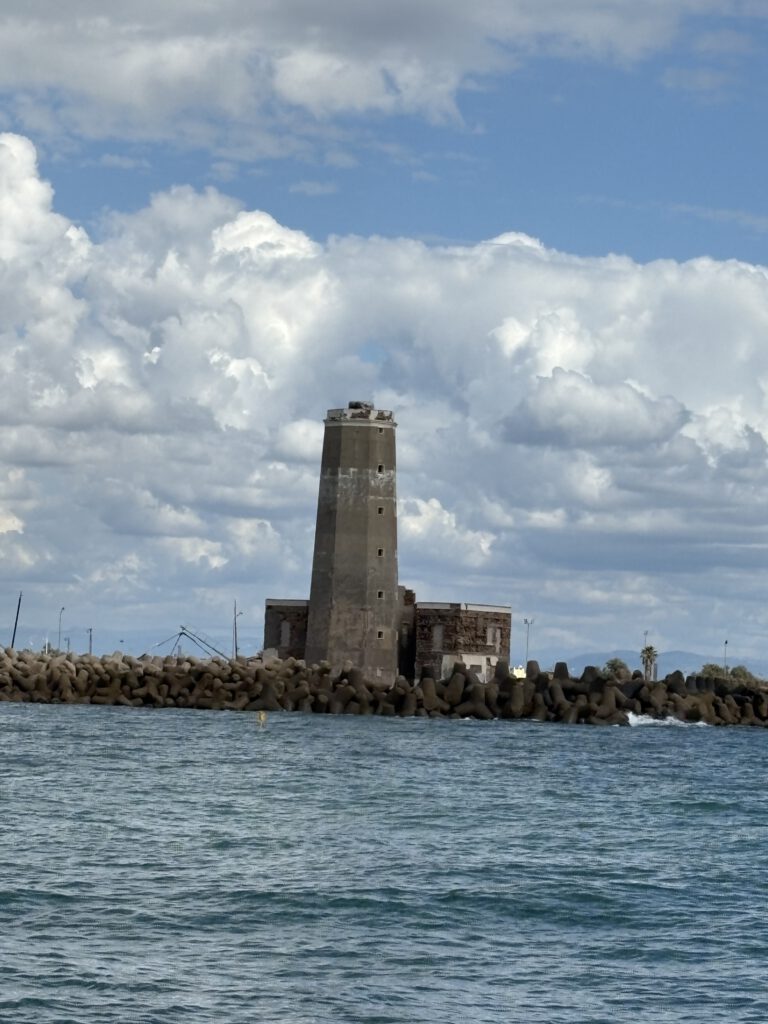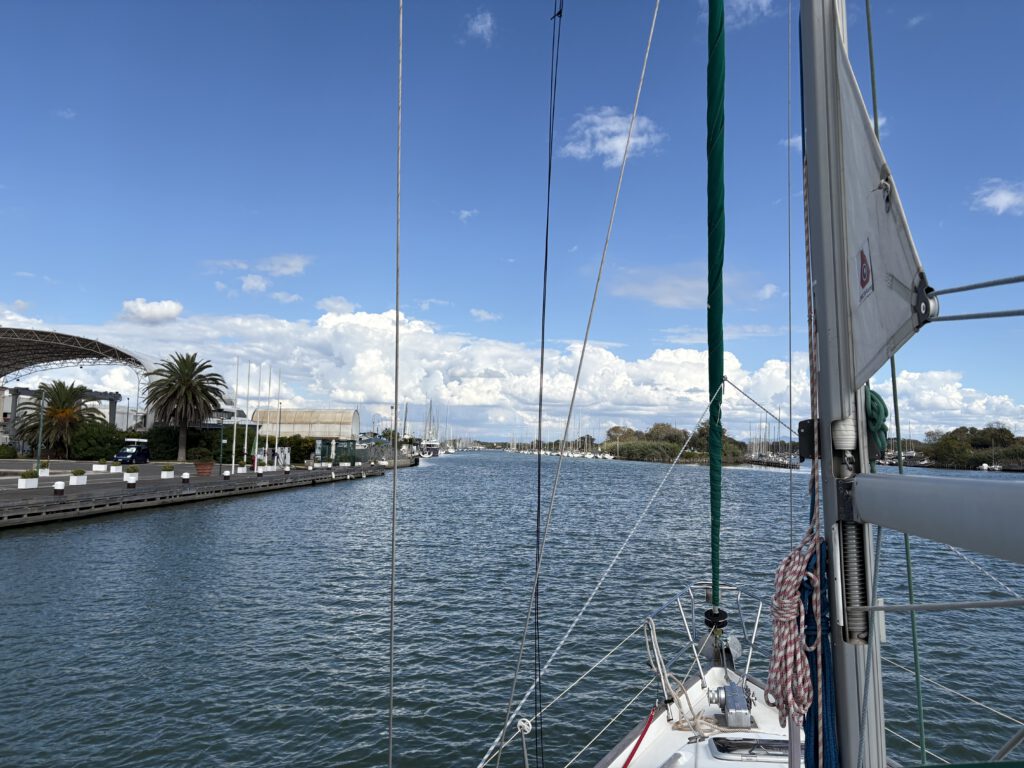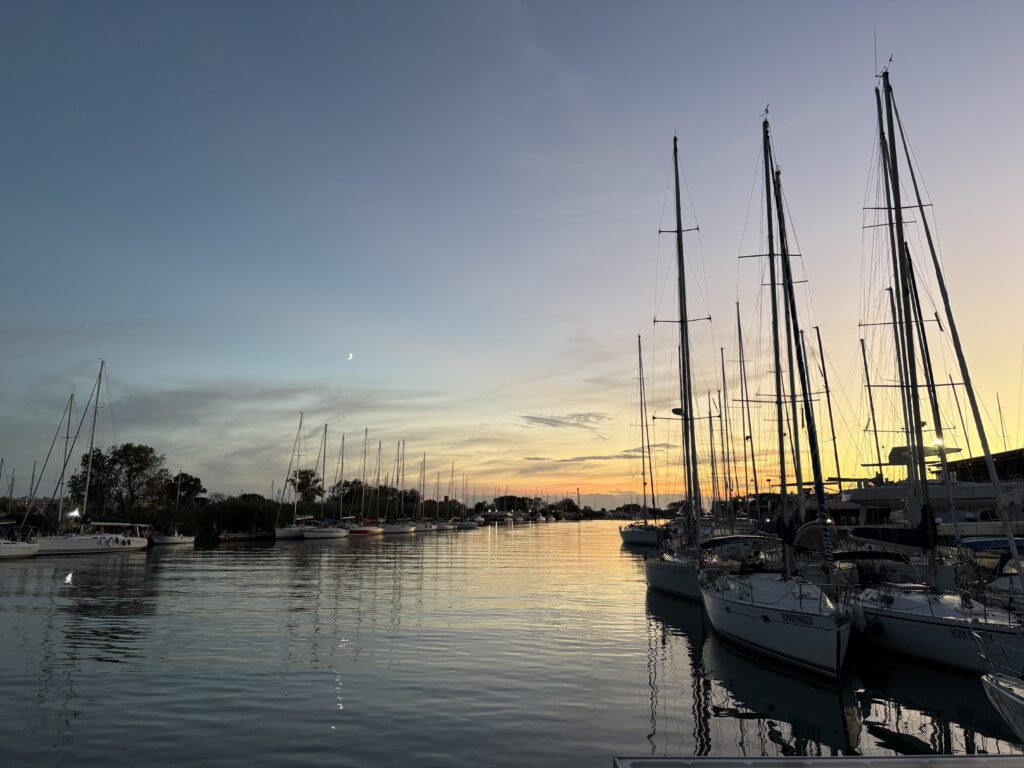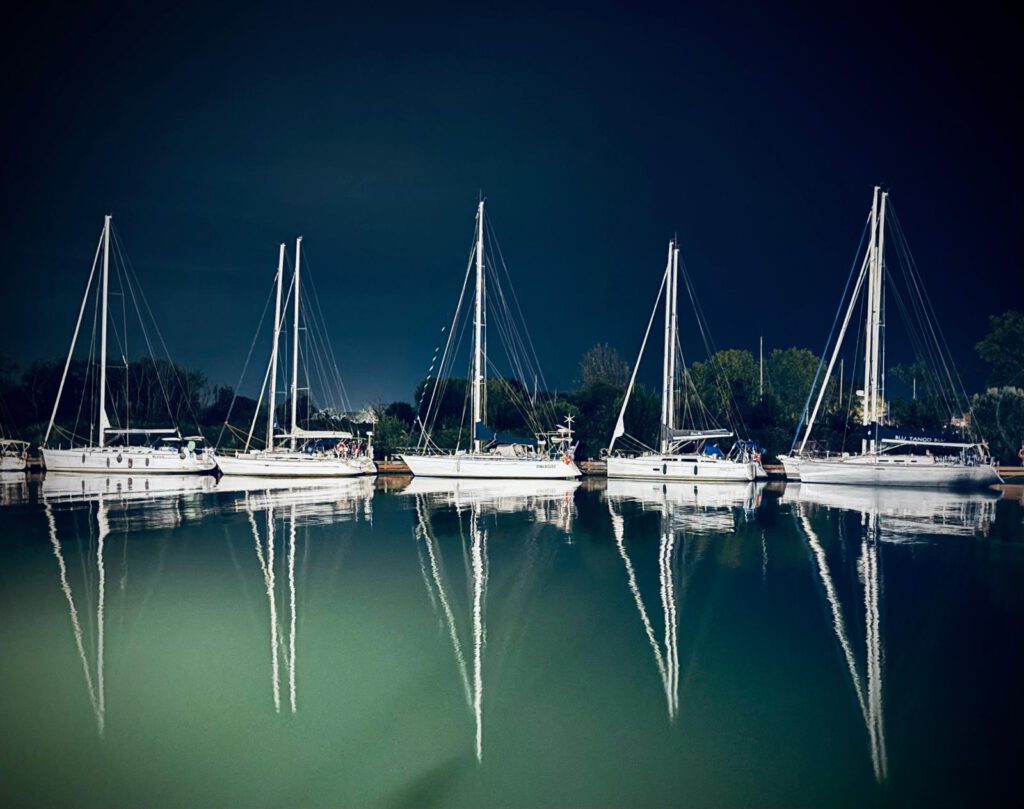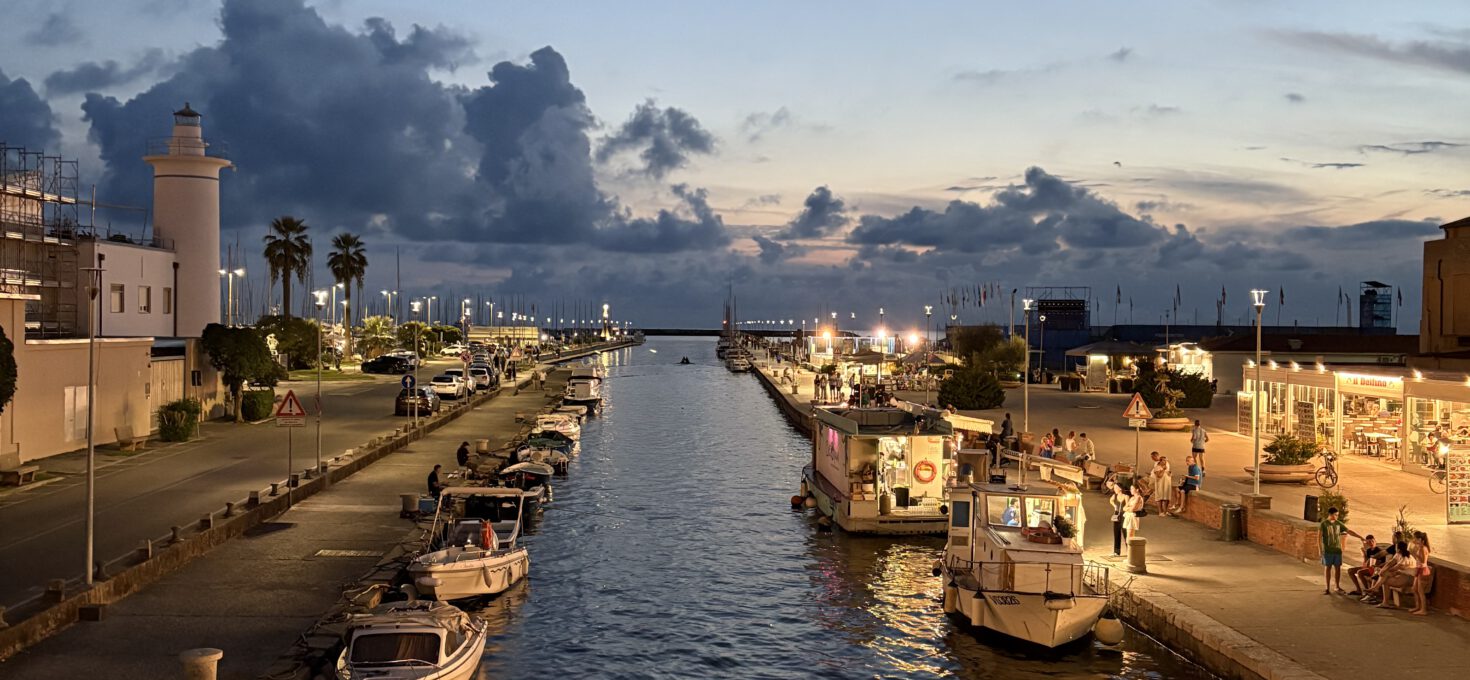08. September 2025 – 27. September 2025
Viareggio
Dark clouds gather on the horizon as we head toward Viareggio, our first stop in Tuscany. The harbor looks very run-down and borders large shipyards. The town is unattractive, apart from the beach promenade. There are some beautiful 19th-century buildings here. Nevertheless, nothing holds our attention, and we set off for Pisa the next day. Because rain is forecast, we set sail early in the morning to arrive at the harbor in time.

Marina di Pisa
The new marina, located at the mouth of the Arno River, is inviting. We reserve a two-night stay because storms and heavy rain are forecast for the coming days. As it turns out, this is the right decision. The weather worsens noticeably, and as we’re out shopping, the first thunderstorm breaks out. It develops into a torrential downpour, even overwhelming our hatches at times. After half an hour, it’s over, but the temperature has also dropped considerably. In addition, the wind is getting stronger. Thankfully, we are safely in the harbor.
The next day, Jeremy comes on board again to sail with us to Rome. We value him as a good friend and competent sailor. The wind is now around 30 knots, producing waves 2 meters high that crash against the harbor’s quayside. Reason enough for us to spend another day in port in Pisa.
We see the black clouds and the numerous flashes of lightning. However, the storm front is passing us to the south. Later, we read in the news that there were heavy rain showers and flooding on Elba and Giglio. We were lucky and only saw the fringes of the dreaded Genoa low pressure system.
Instead of sailing any further, we decide to take the bus to Pisa and explore the city. We are not disappointed. Pisa is a lively Italian city with many young people. The cathedral district with its famous leaning tower is worth seeing, even if it is crowded with tourists. Fortified with Aperol Spritz and pizza, we are fit for the next day at sea.
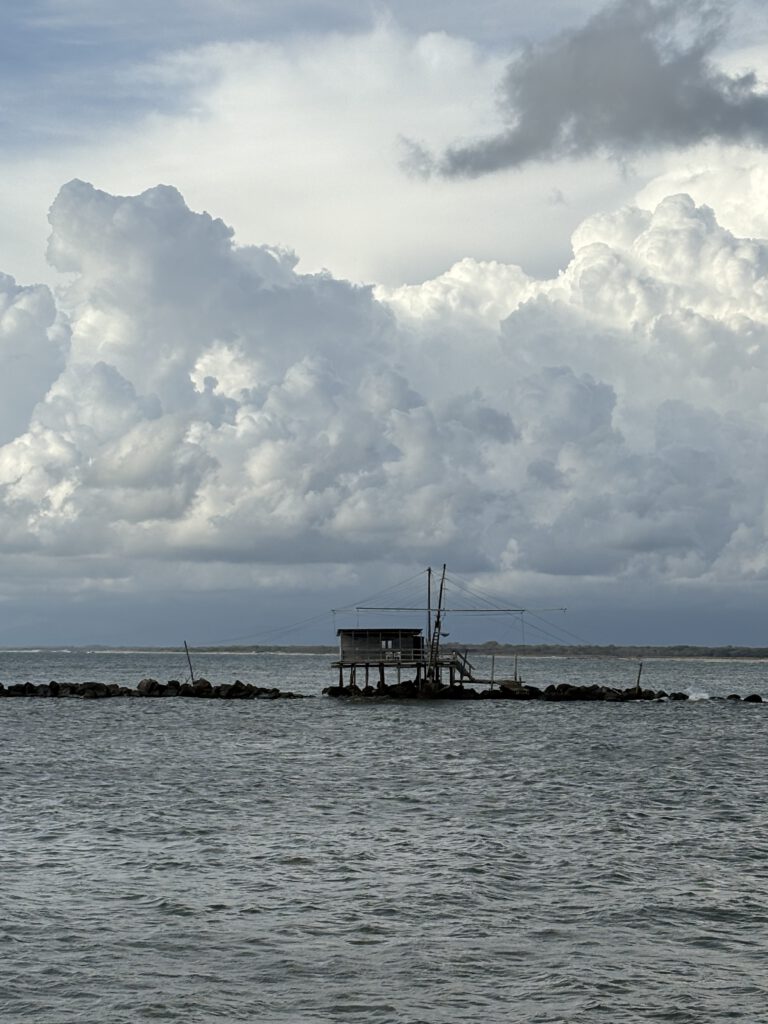
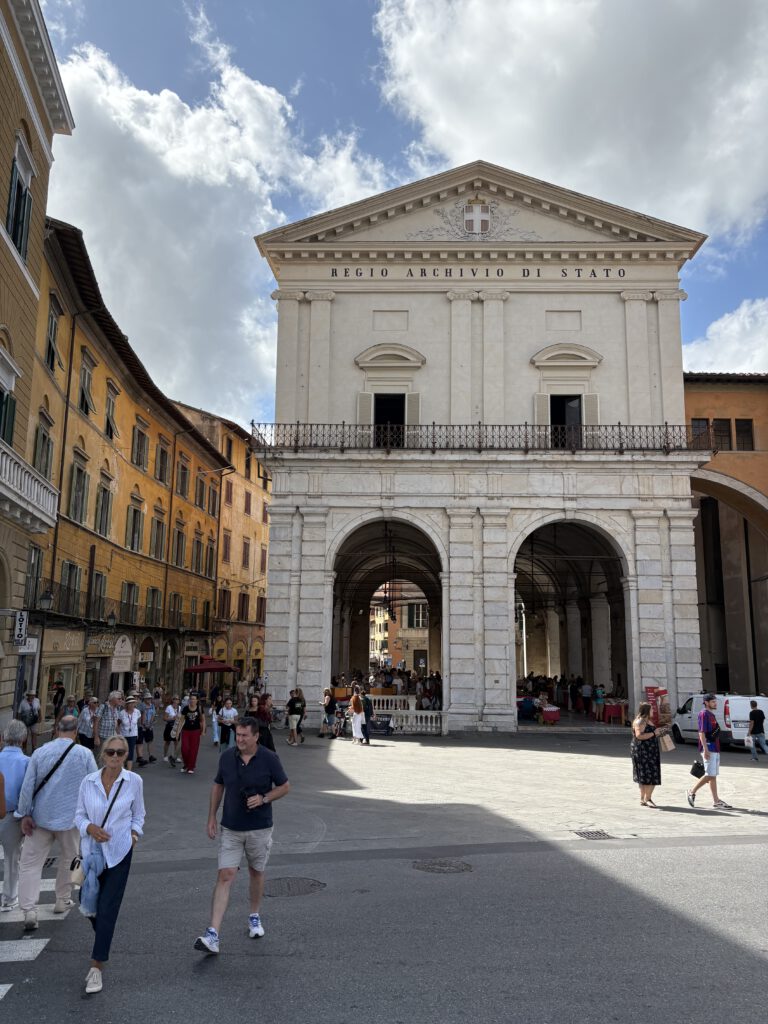
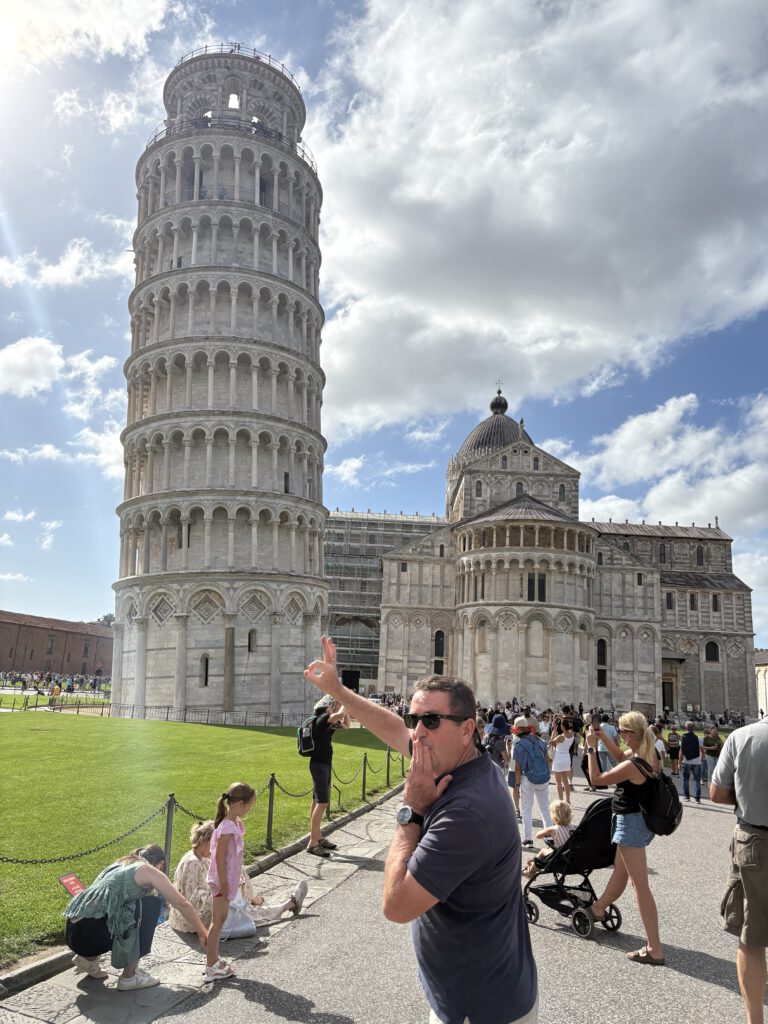

Rosignano – Marina Cala de Medici
South of Pisa, we sail past Livorno. A truly unattractive industrial port and a port of call for numerous cruise ships. Our next stop on the way south is Rosignano Solvay, a modern marina in a dull town. No reason to stay here.
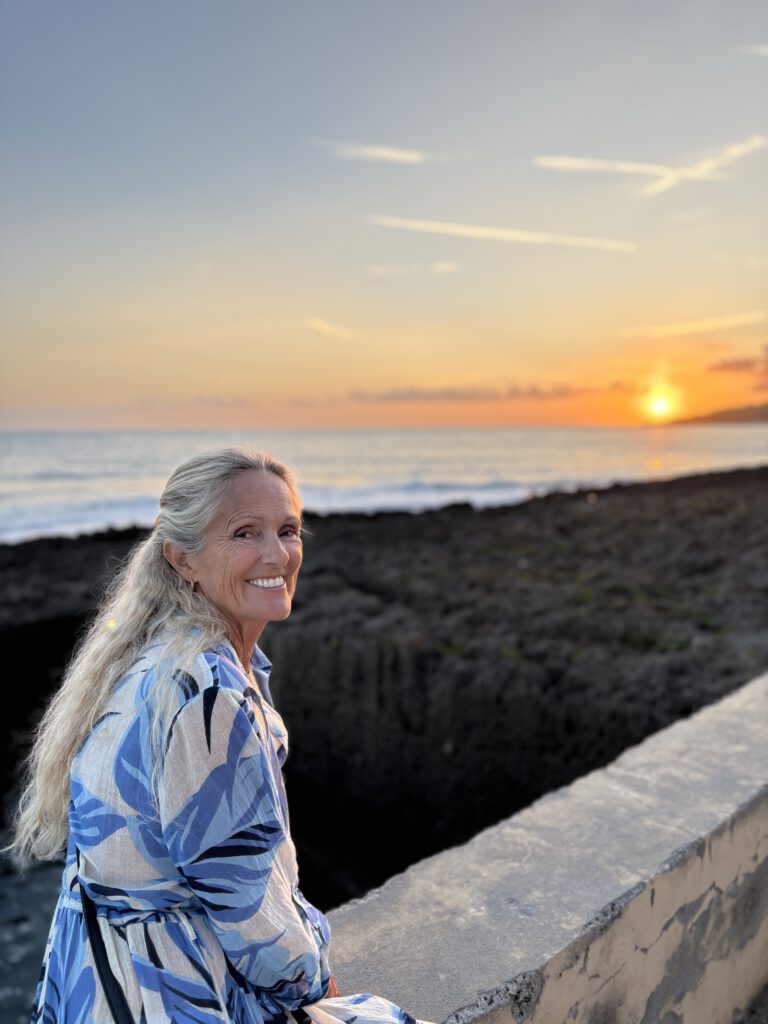
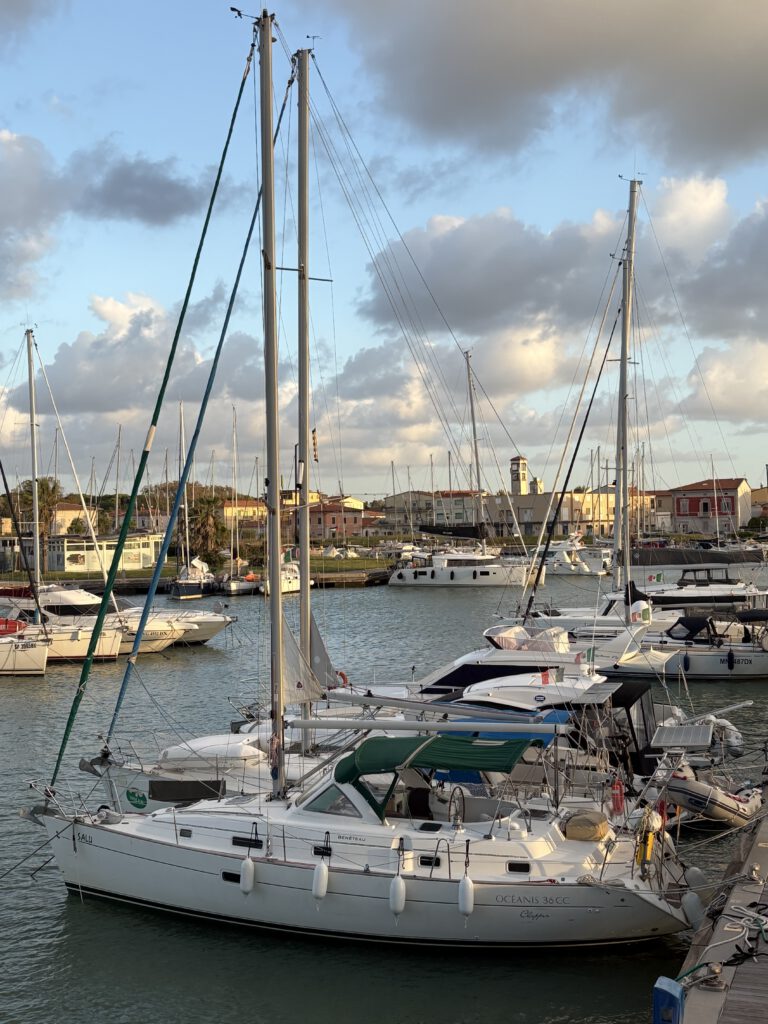
Gulf of Baratti
Before crossing to Elba, we anchor for a night in one of the few bays on this coast. The Gulf of Baratti is large and shallow, and we anchor in 3 meters of water. Beautiful pine forests and stretches of beach surround us. We spend the evening in a good restaurant right on the beach. The night is rough. We encounter considerable swell, and the anchor alarm goes off at 5 a.m. because Uwe didn’t set the radius large enough. Only in the morning does the sea calm down, and we enjoy a morning swim in the 24-degree Mediterranean. The next day we plan to sail to Elba.
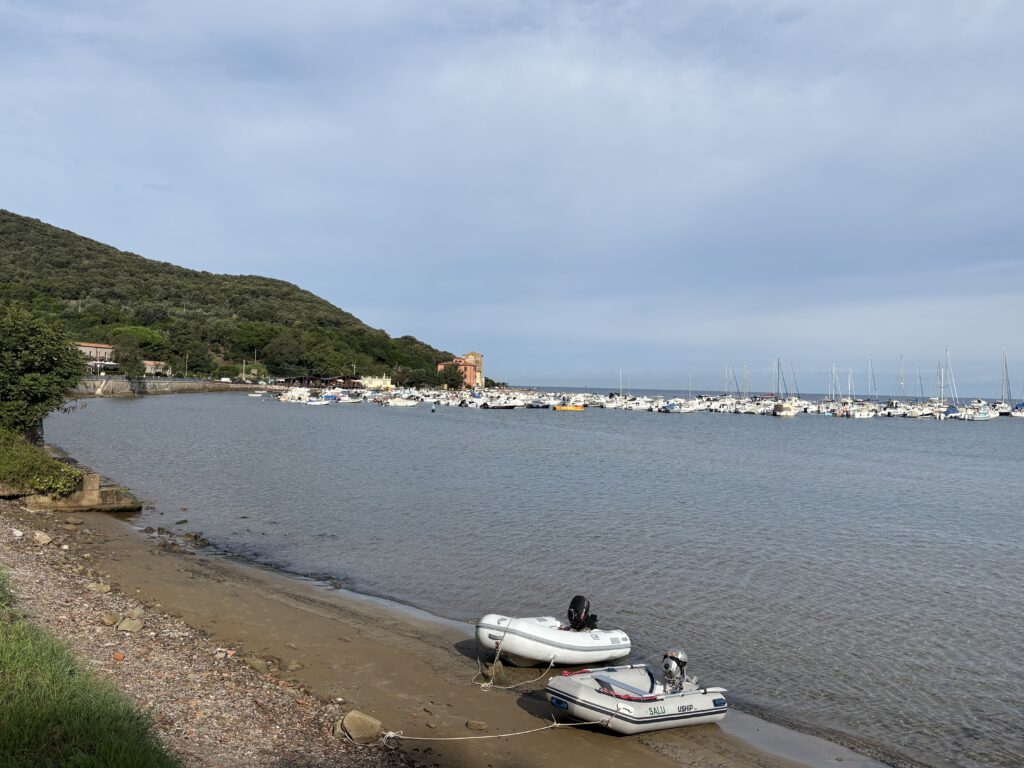
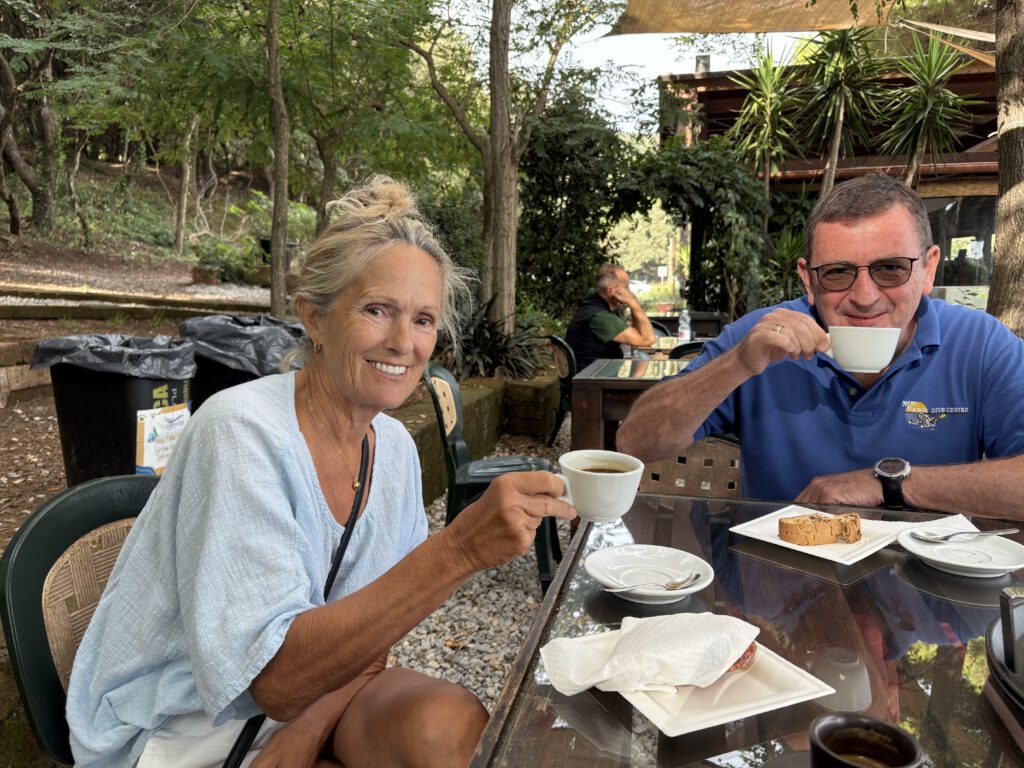

Elba, Portoferraio
Elba is the most beautiful place we’ve visited so far on our trip to Italy. Instead of endless beaches, there are numerous beautiful bays and charming little towns with plenty of charm.
Our first stop is Portoferraio. After navigating the busy ferry traffic between Piombino and Elba, we enter the old port of Portoferraio and moor at the pier in the middle of the old town. We’re immediately captivated by Elba’s main town. It’s full of Italian life, and the street runs just beyond Salu. In the evening and at night, however, it’s closed to traffic and transformed into a promenade. We’re captivated by the light on the island and the spectacular sunsets. Because the weather forecast predicts only light winds for the coming days, we decide to take a leisurely counterclockwise sail around the island.
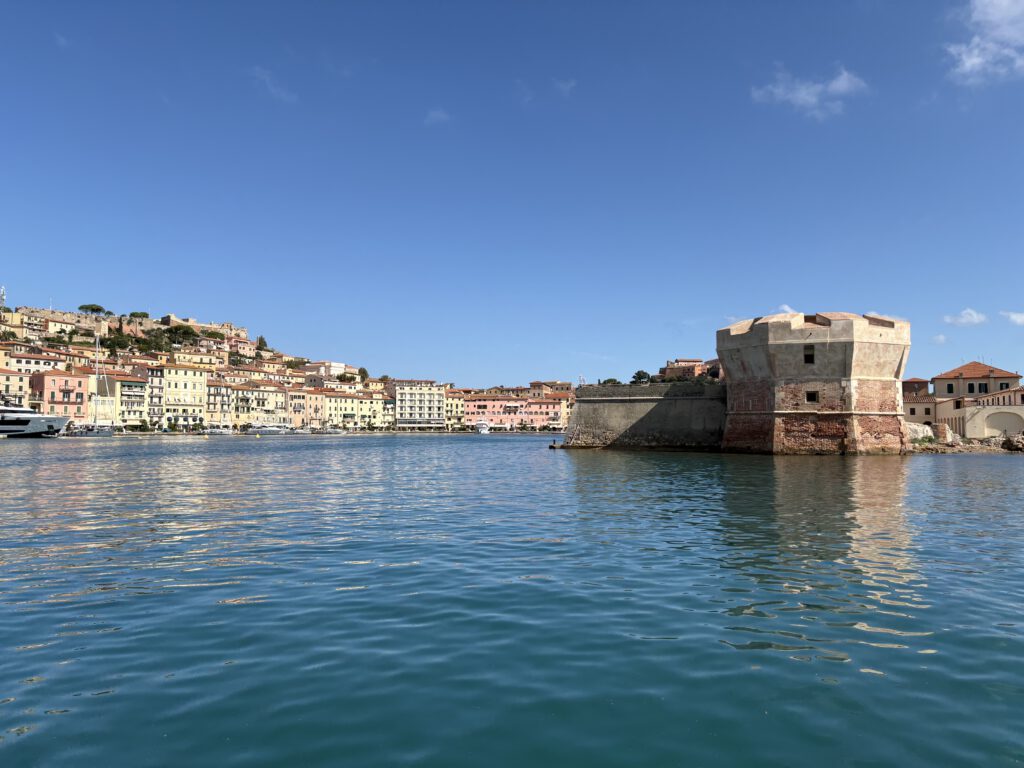

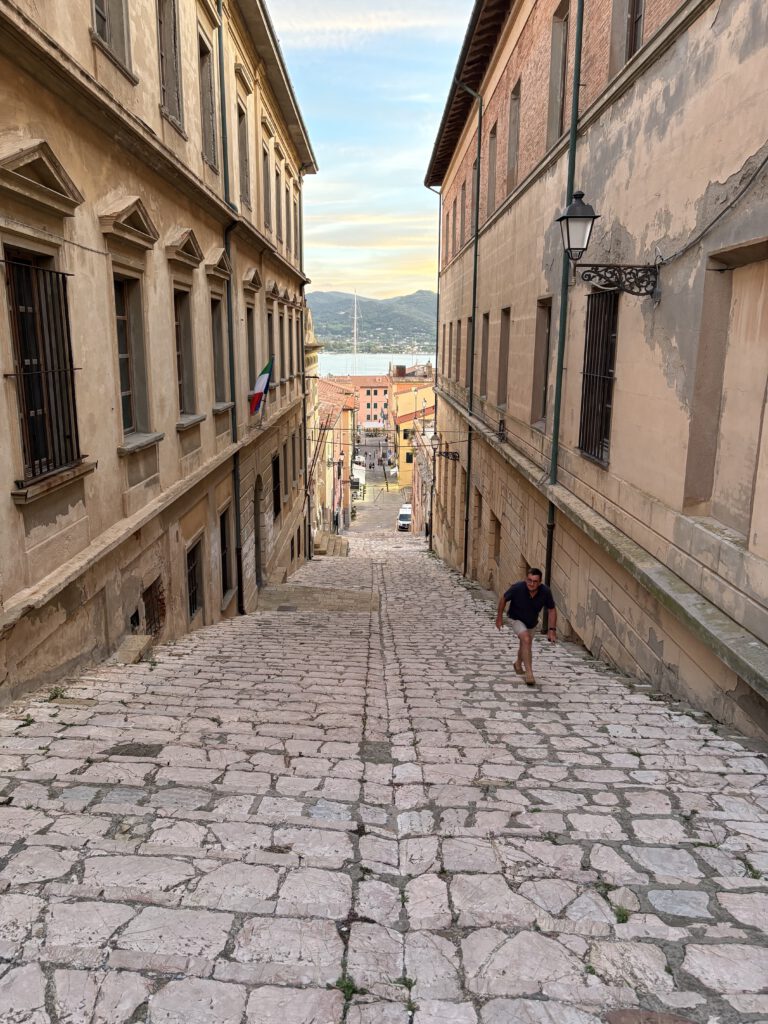
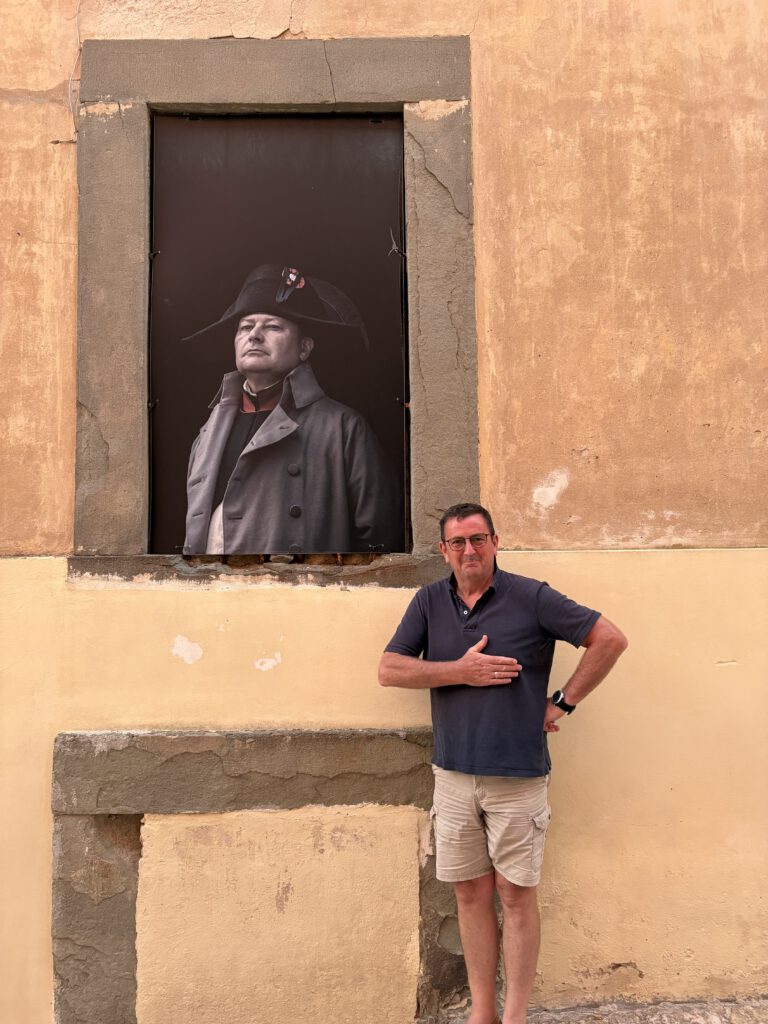
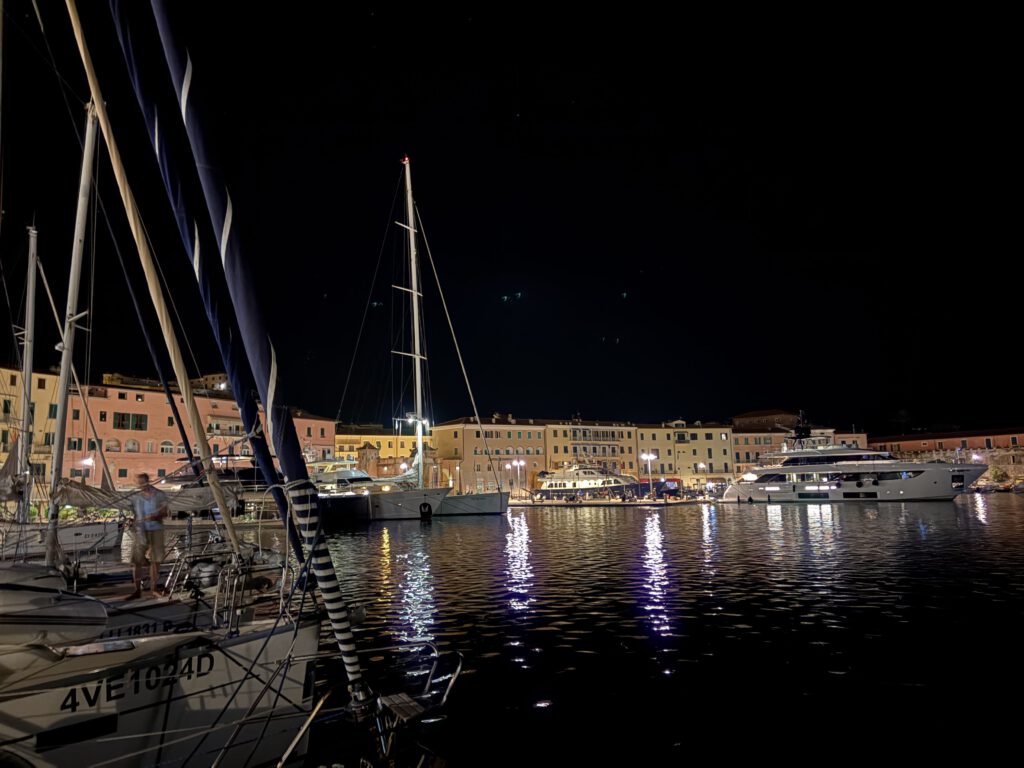
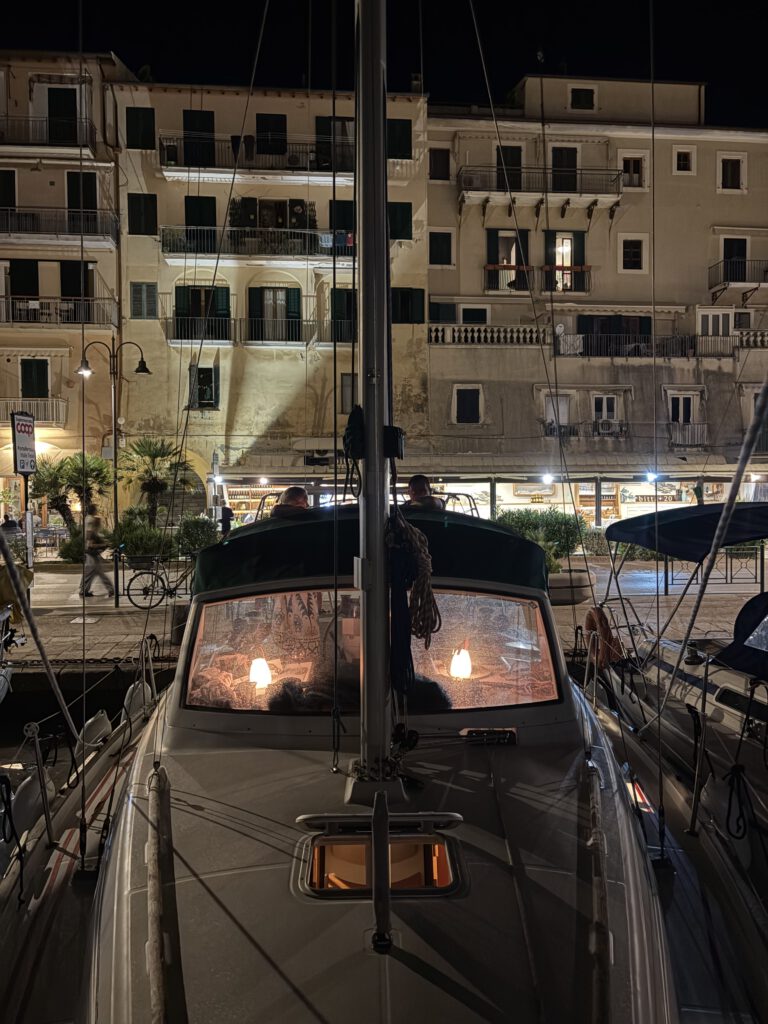
Golfo di Biadola
Just 9 nm along the coast lies the beautiful bay of Biadola, which we choose as our next anchorage. Here we are moored close to the beach with only a few other boats. The Aperol Spritz at the beach bar and the sunset are spectacular. Although there is almost no wind at night, we still experience some swell, resulting in a somewhat restless night. The next morning, the sea is calm again, inviting us to take our first dip. At 24 degrees Celsius, the Mediterranean is pleasantly warm, and we decide to swim extensively in it over the next few days.

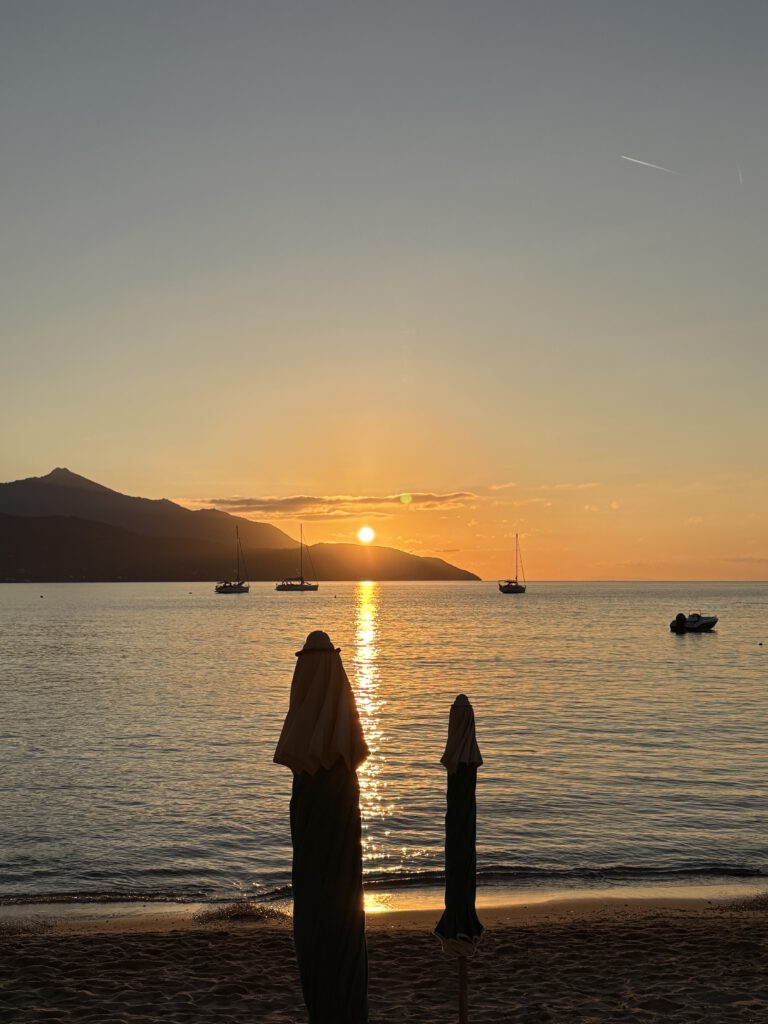

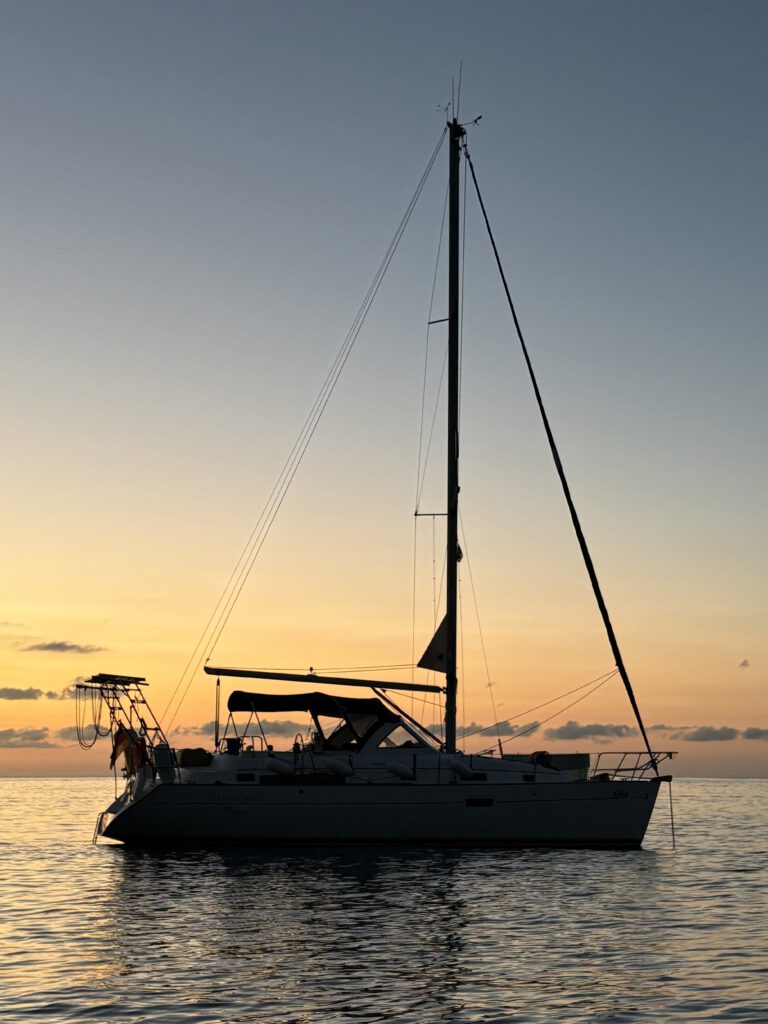

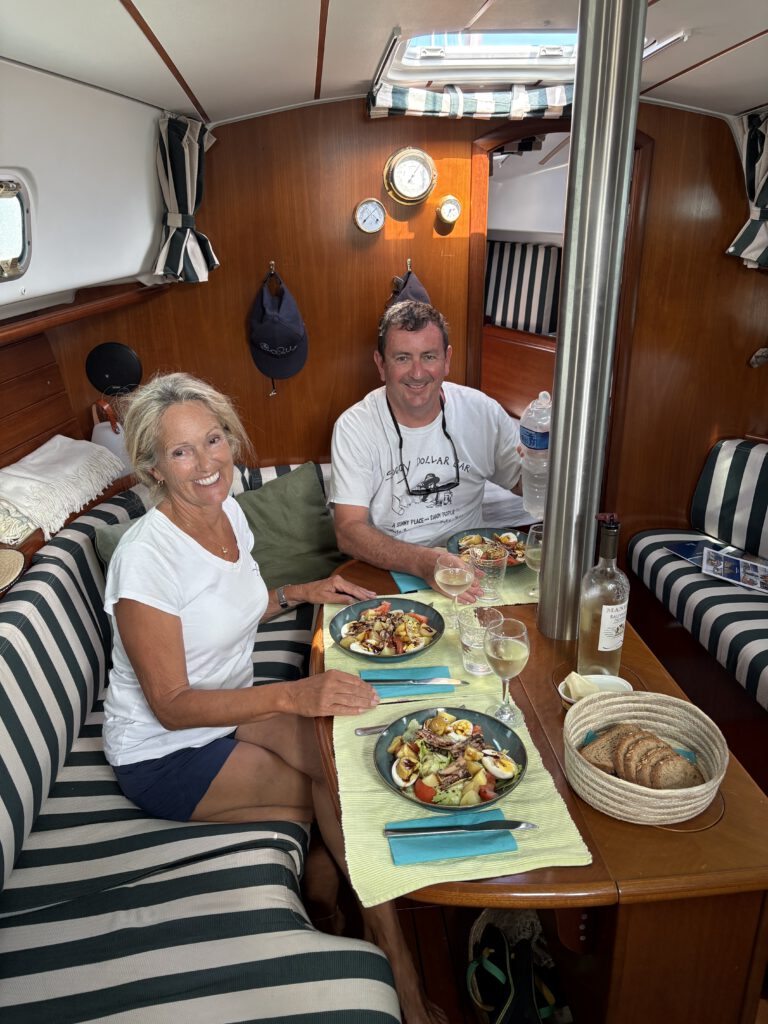
Marina Marciana
Our next stop is just a stone’s throw away. We moor in the small harbor of Marina Marciana, run by the local yacht club. The lovely town has managed to retain its charm and, as the smallest town on Elba, is not overrun by tourists. A very helpful mechanic fixes a small technical system. We need a seal on the gearbox, and he gives us a second one as a spare. All for free. In the evening, we sit in the central piazza in front of the church and enjoy dinner with local wine.
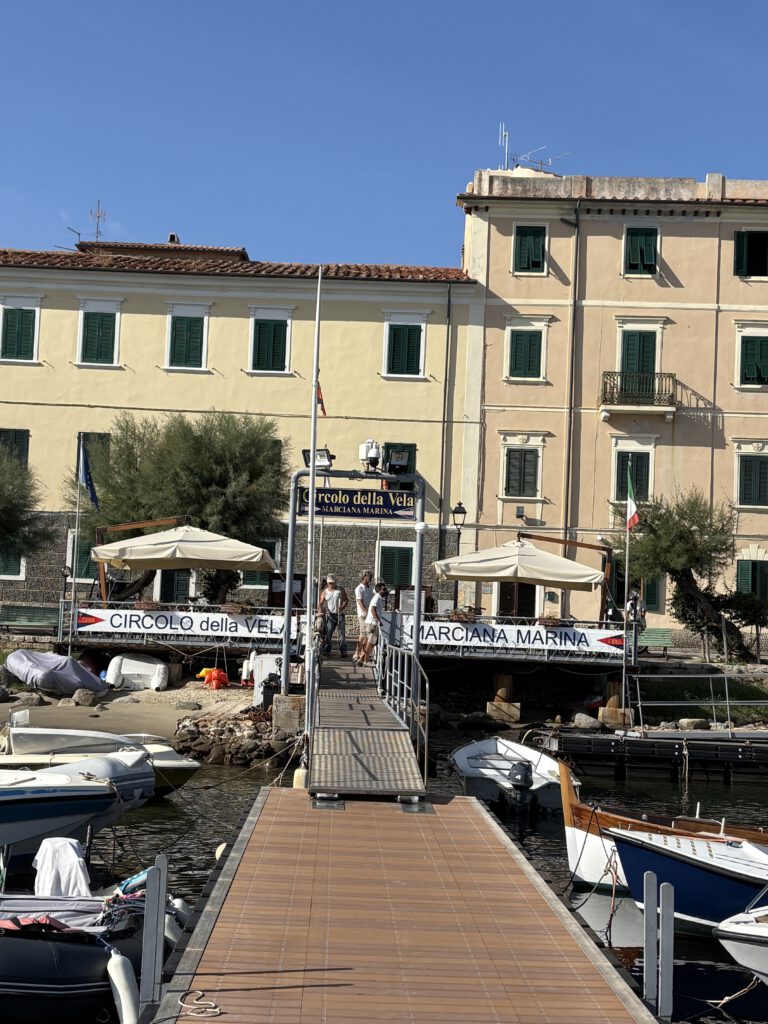
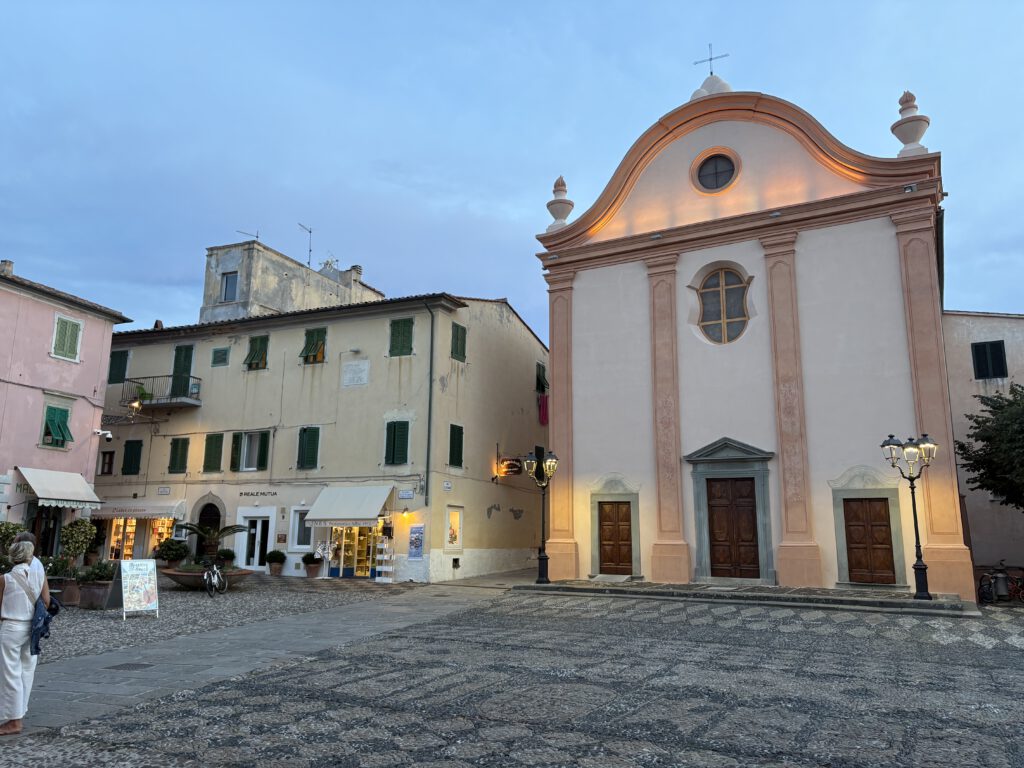
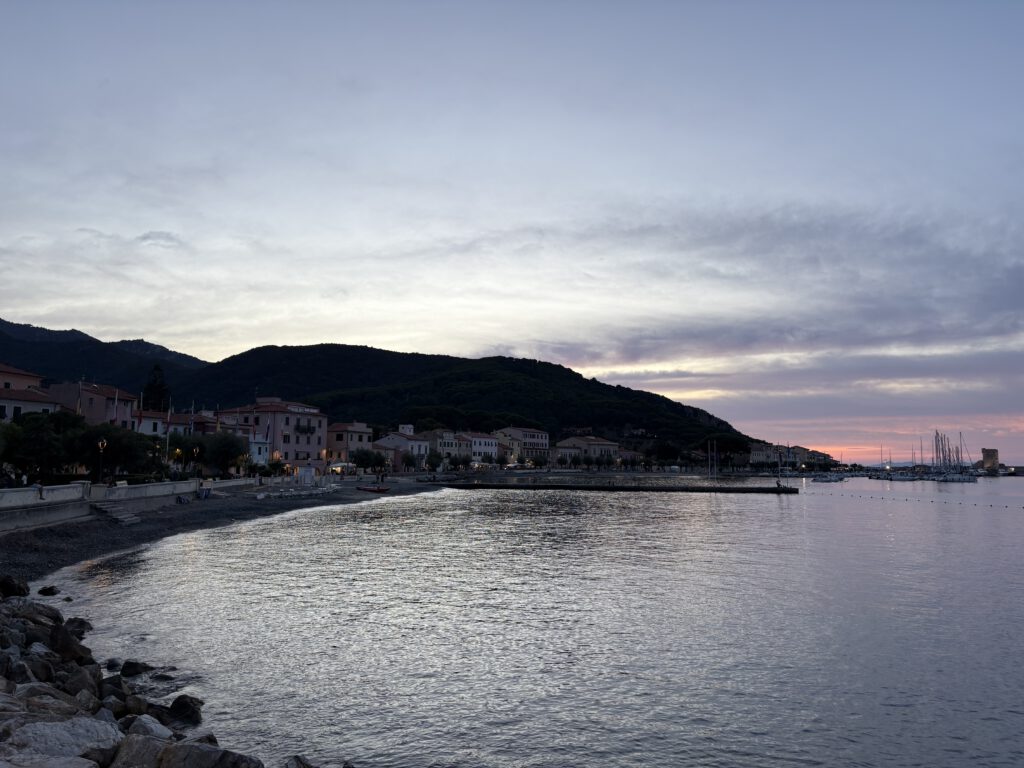
Marina di Campo
With a wonderful tailwind, we sail around the west coast of Elba to the other side of the island. Here, we plan to moor in the small town harbor of Campo nell’Elba. It’s not really a harbor, but rather a harbor wall and a short quay that protects against the southerly winds. On the way to Campo, we stop for lunch in the crystal-clear waters of Fetovaia Bay.
Campo is much livelier than Marina Marciana. We still like the place. It exudes a laid-back Italian holiday atmosphere. After dinner, we head to the local ice cream parlor. The Italians are really good at making ice cream.



Golfo di Lacona
After the port of Campo, we decide to spend another night at anchor. This time in the Bay of Lacona, just around the corner. There are just five other yachts anchored with us in the large bay. The sunset and the evening sky are also spectacular here. The sea shimmers golden in the evening light, and we enjoy a peaceful night and a long swim the next morning in the crystal-clear waters of the bay.
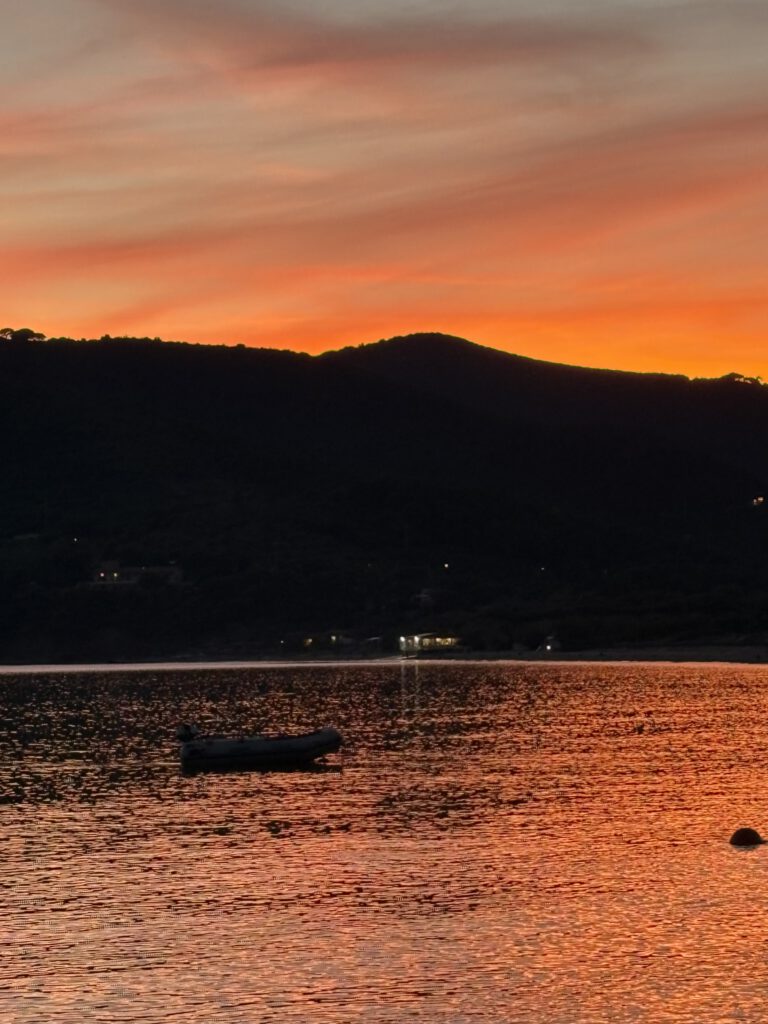
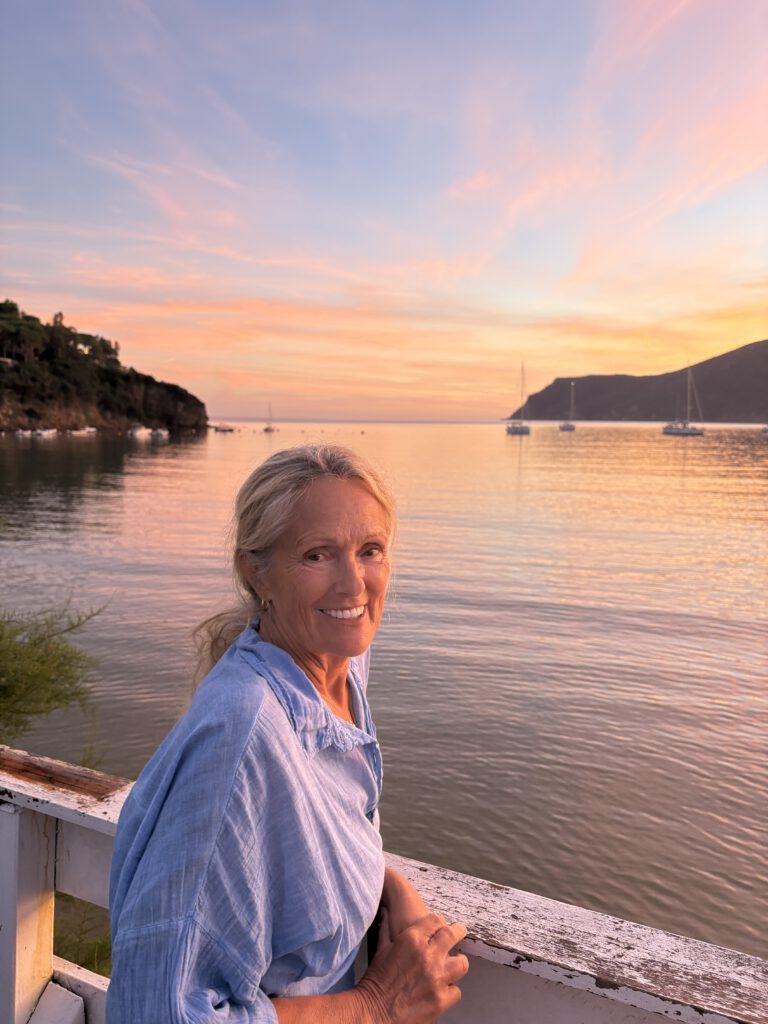

Porto Azzurro
Before we enter our last port on Elba, we anchor for lunch in the small bay of Calanova, just a few hundred meters from the port of Porto Azzuro. The small town welcomes us with a strong Italian flair. Guarded by two medieval fortresses built by the Spanish, Porto Azzurro is another worthwhile stop on Elba.
The next morning, it’s time to say goodbye to the island we loved so much. We decide to return here next spring and spend some time in the bays and harbors of Elba, perhaps crossing over to Corsica from here. Now it’s time to head back to the mainland.

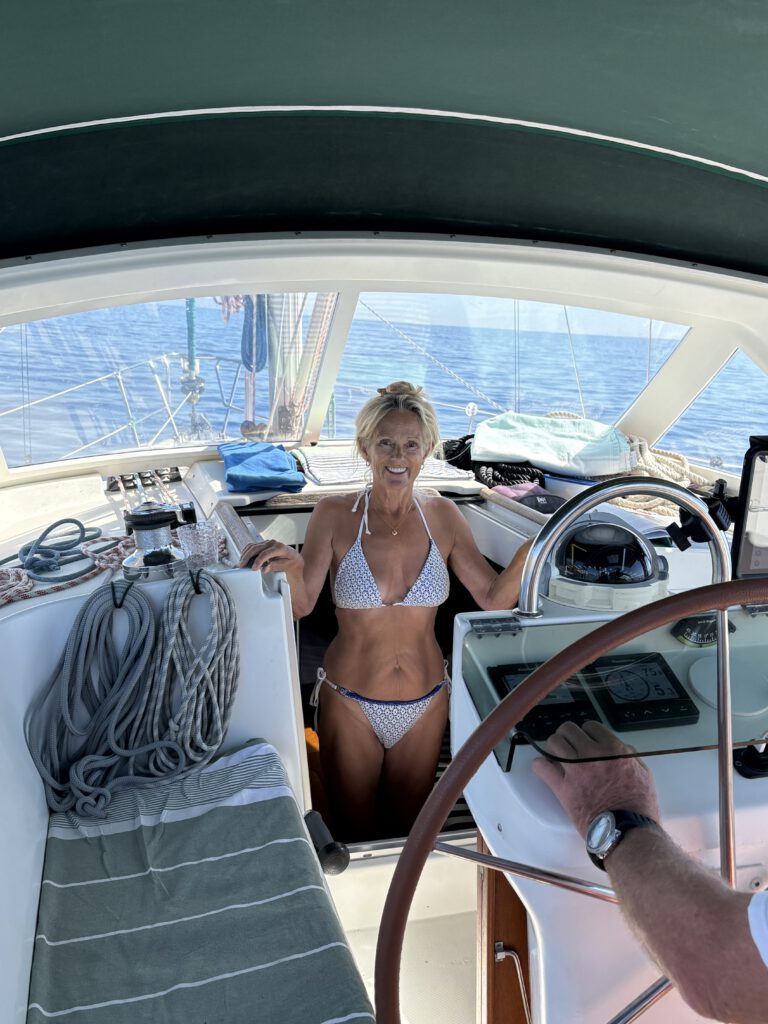
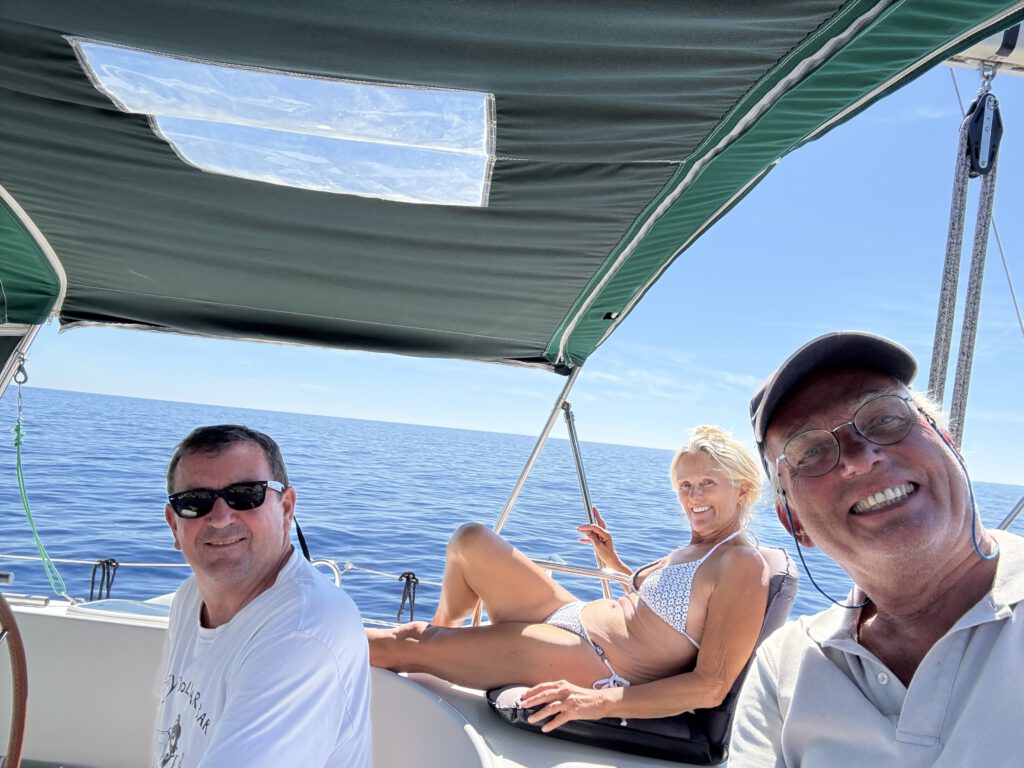


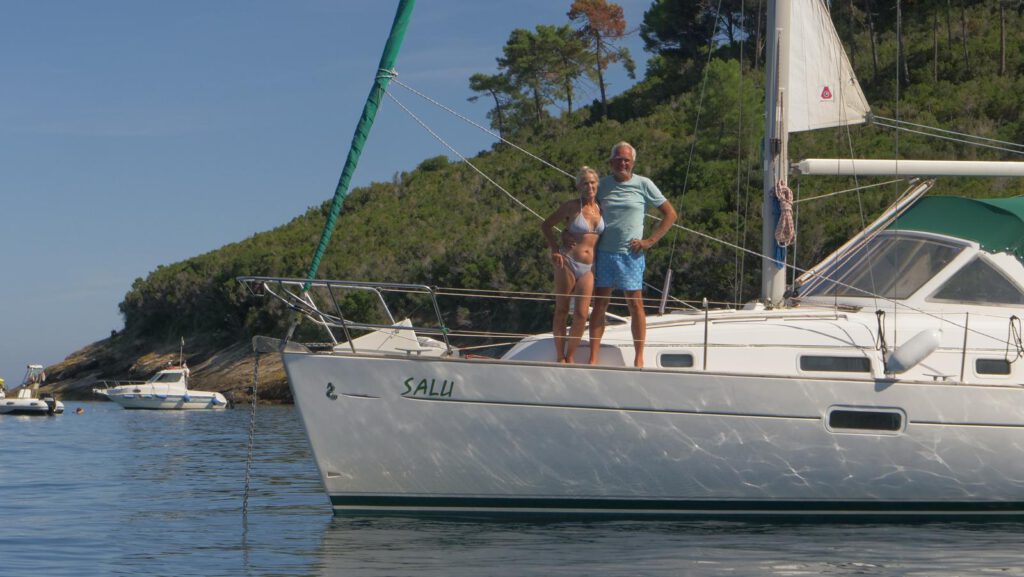
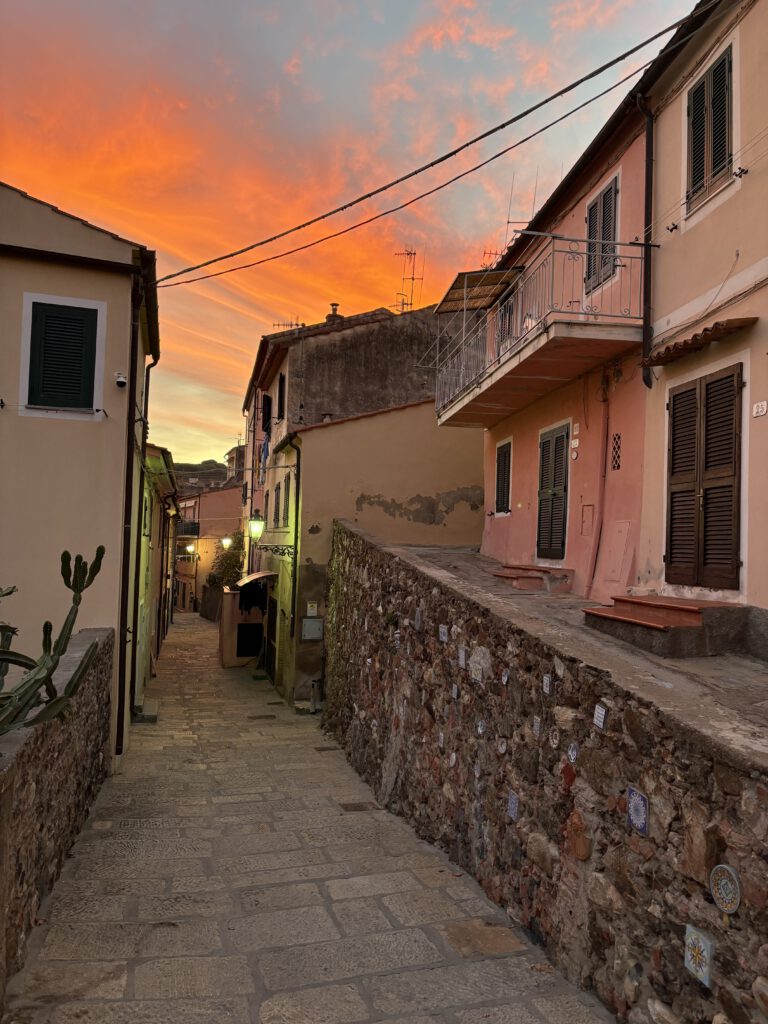


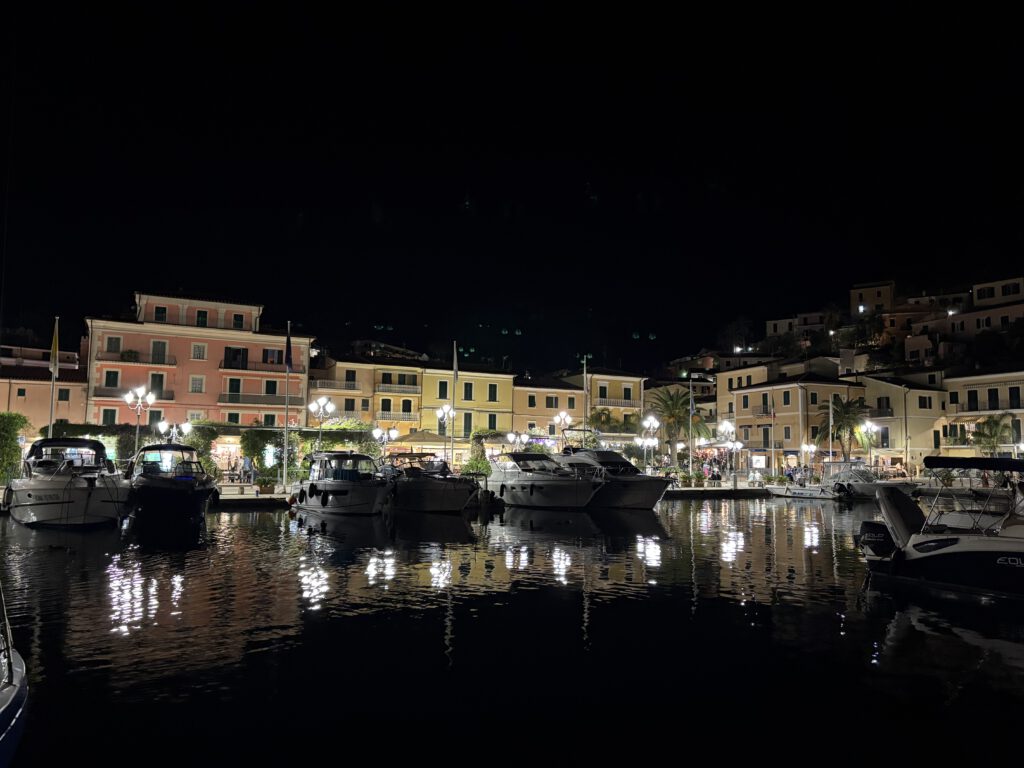
Punta Ala
With a good sailing wind of 15 knots, we speed the 15 nm to Punta Ala, a modern marina on the mainland that serves as a departure point for many charter boats. The harbor isn’t attached to a single town, but rather built as a large holiday resort. After a lunch stop in front of the harbor entrance, we moor there in the afternoon, feeling a little sad about leaving Elba behind. Now, however, we can focus on our final legs to our destination in Rome. The weather forecast for the next few days predicts another thunderstorm front and strong winds. Therefore, we head for the harbor of Grosetto, Porto Maremma, to wait out the storm.
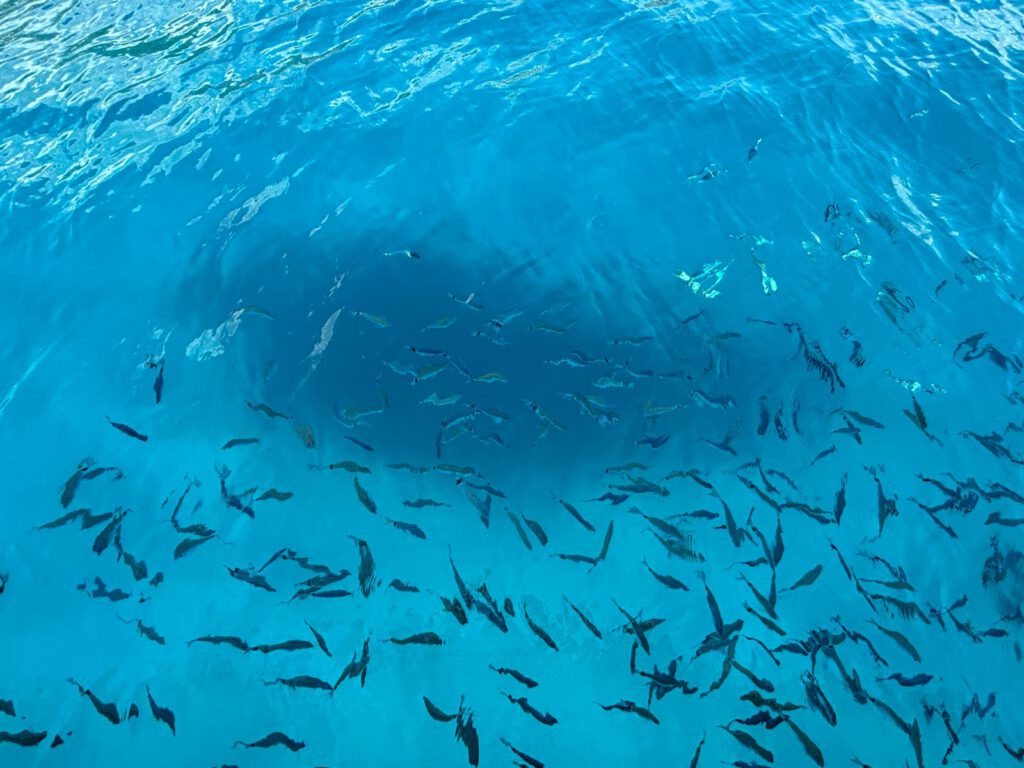
Grosetto, Porto Maremma
The extra day in port gives us the opportunity to visit the small town of Grosetto, located 12 kilometers inland. So we take the bus and explore Grosetto. The central town of the Maremma region is surrounded by intact city walls and has an inviting feel. The square in front of the 13th-century cathedral is lined with noble palaces, and the old town boasts many charming shops and bars. Before the forecast rain sets in in the afternoon, we head back to the port.
The rain doesn’t arrive until the night, accompanied by thunderstorms with lightning and thunder. We’re safely in port and decide to wait until after we get up to decide whether to continue sailing the next morning.
The next morning, the sky seems to be clearing up a bit, and we set sail toward Porto San Stefano. We’ve barely left the port when it starts to rain heavily. The wind remains light, but the rain forces us to put on oilskins. Only shortly before reaching the port of San Stefano does the rain stop, and we are able to enter the harbor, soaked to the core. The sky around us remains dark gray, and rain continues to fall intermittently over the next few hours.
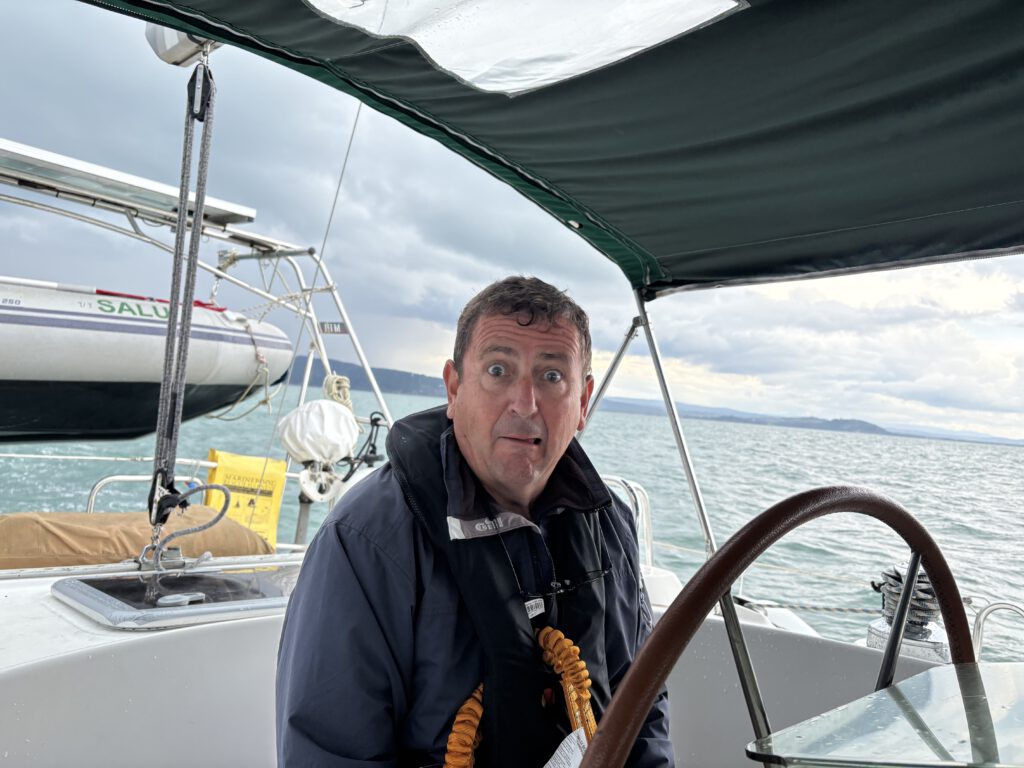
Porto San Stefano, Monte Argentario
This town is a busy ferry port for the island of Giglio, which lies just a few miles off the coast. In the afternoon, numerous fishing boats moor in the harbor basin and sort their catch. Right on the pier, there are two large market stalls selling fish.

Porto Ercole, Monte Argentario
Porto Ercole, on the other side of Monte Argentario, is completely different from San Stefano. Protected by two mighty fortresses, lies the small town with its harbor. From here, we take the bus to Ortobello, a small town on a promontory that was once a harbor and is now surrounded by two shallow lagoons and no longer has access to the sea. The town’s former importance is evident. Now it’s a bit sleepy and out of date.
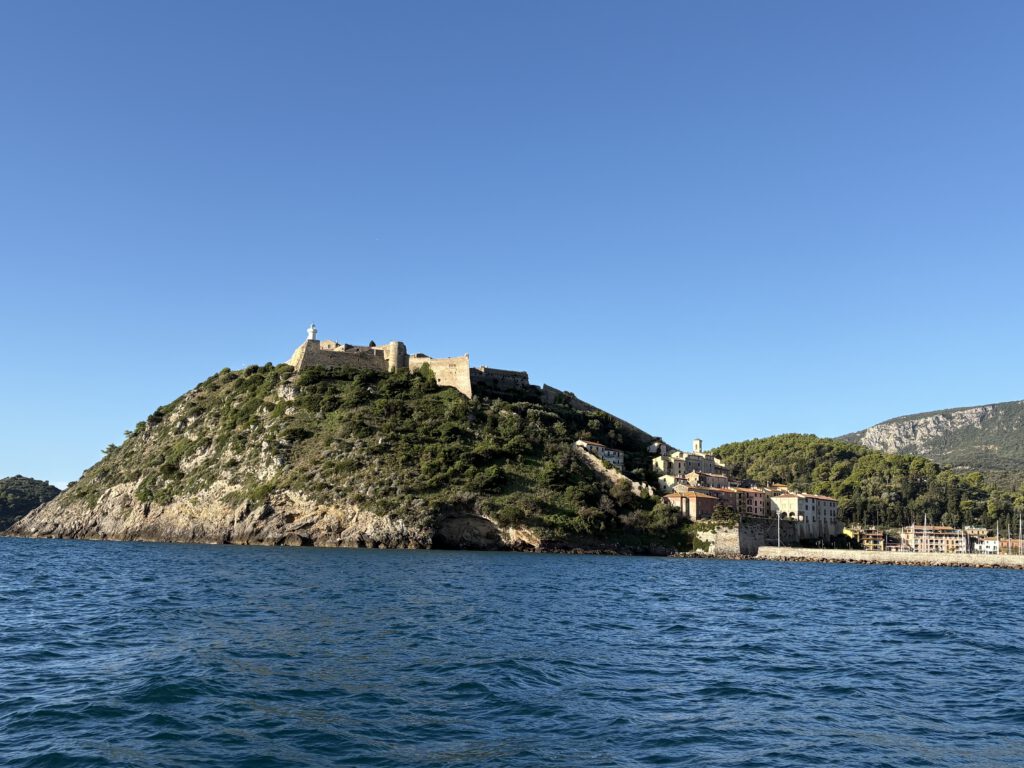
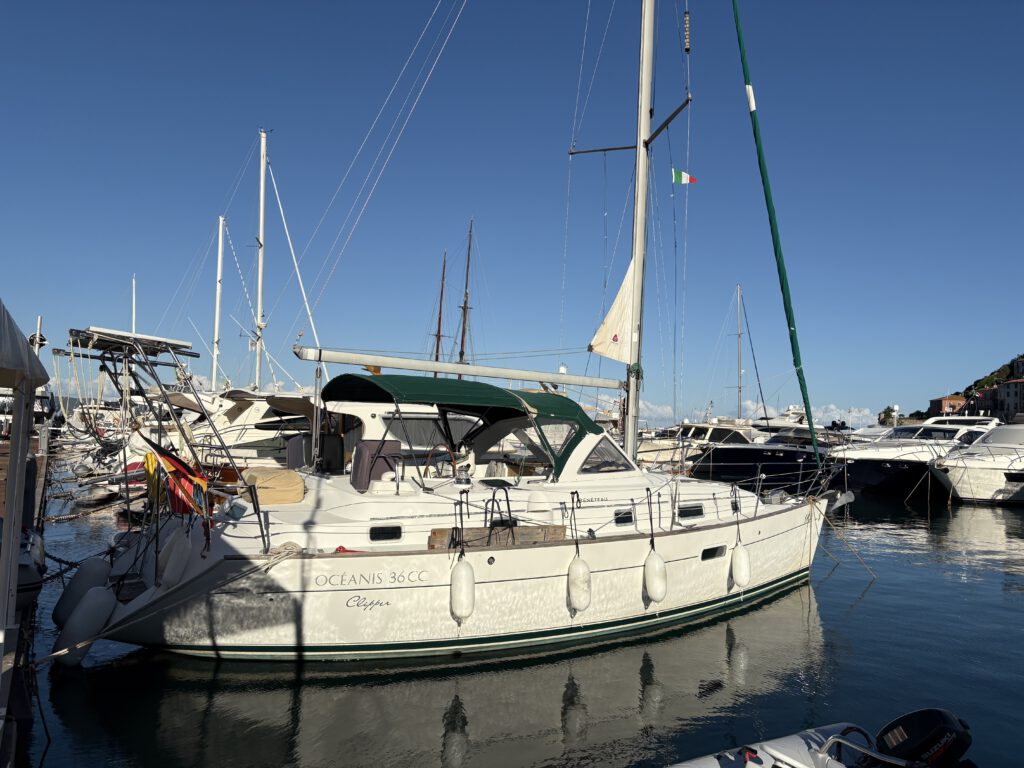
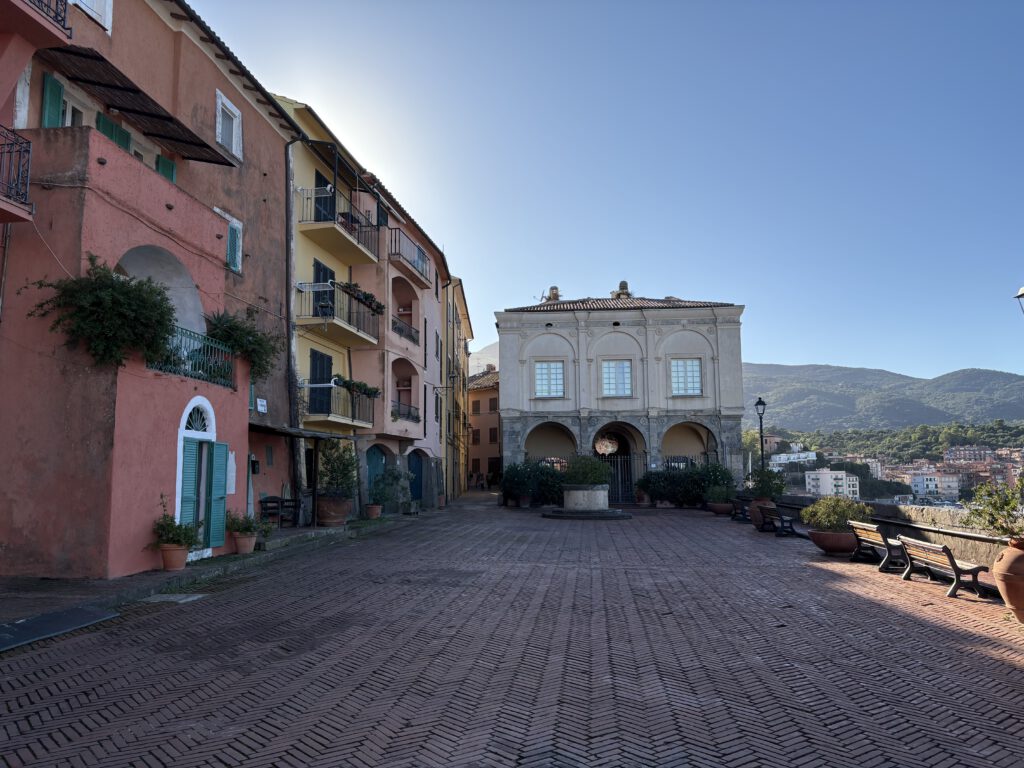
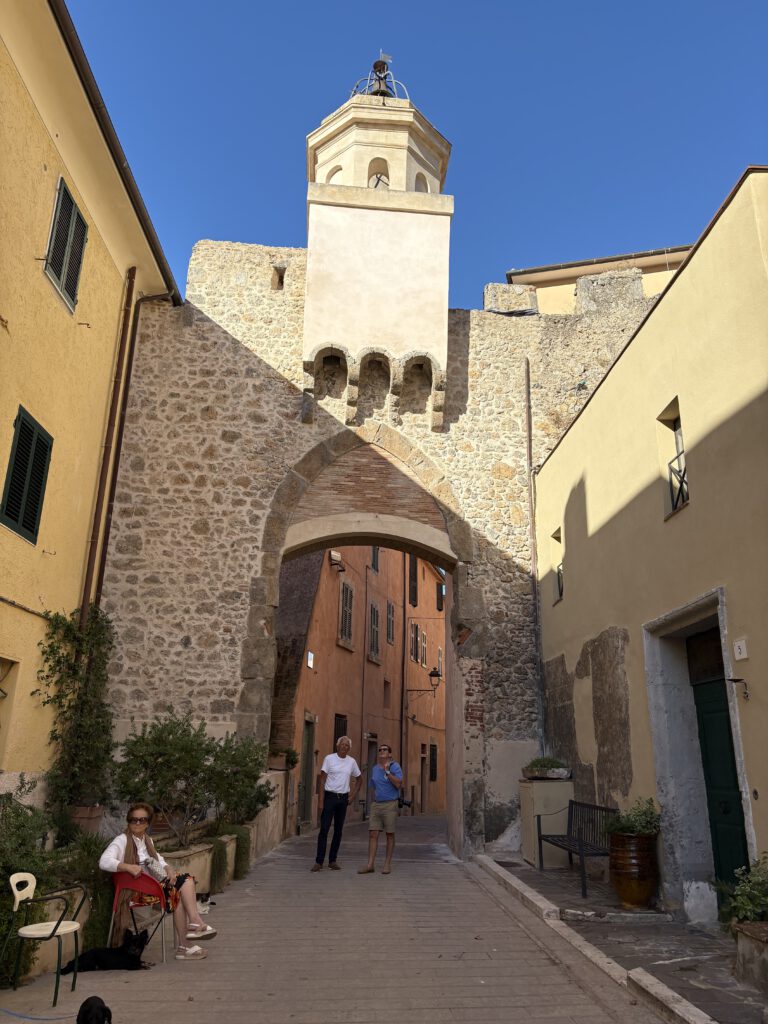
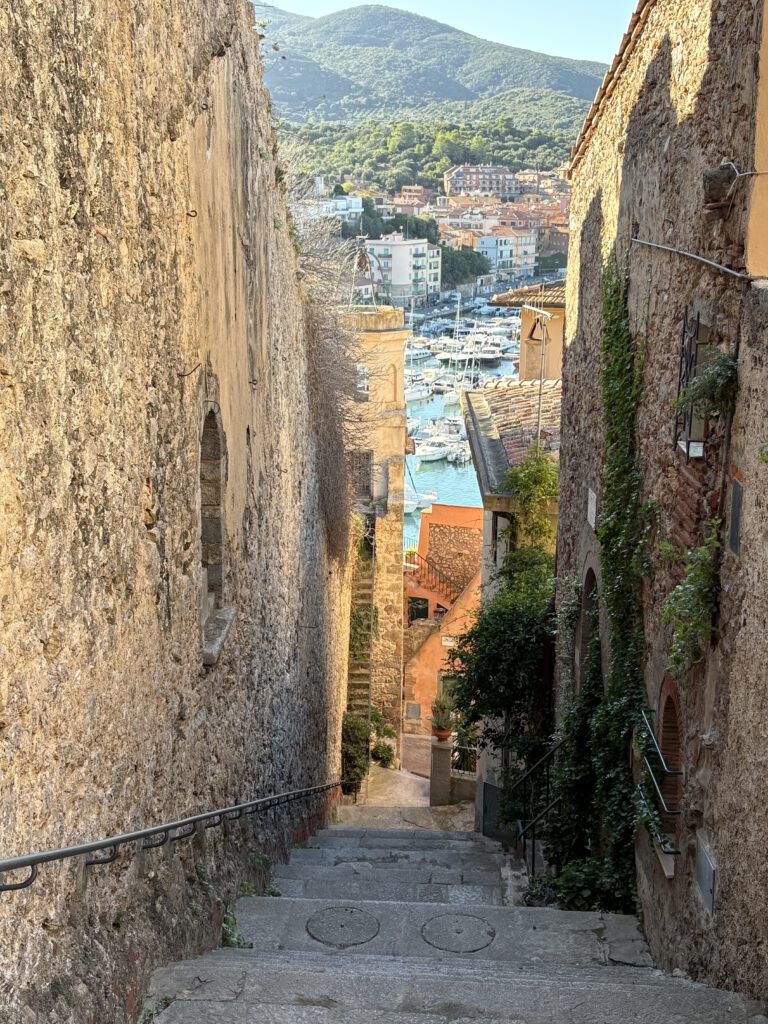
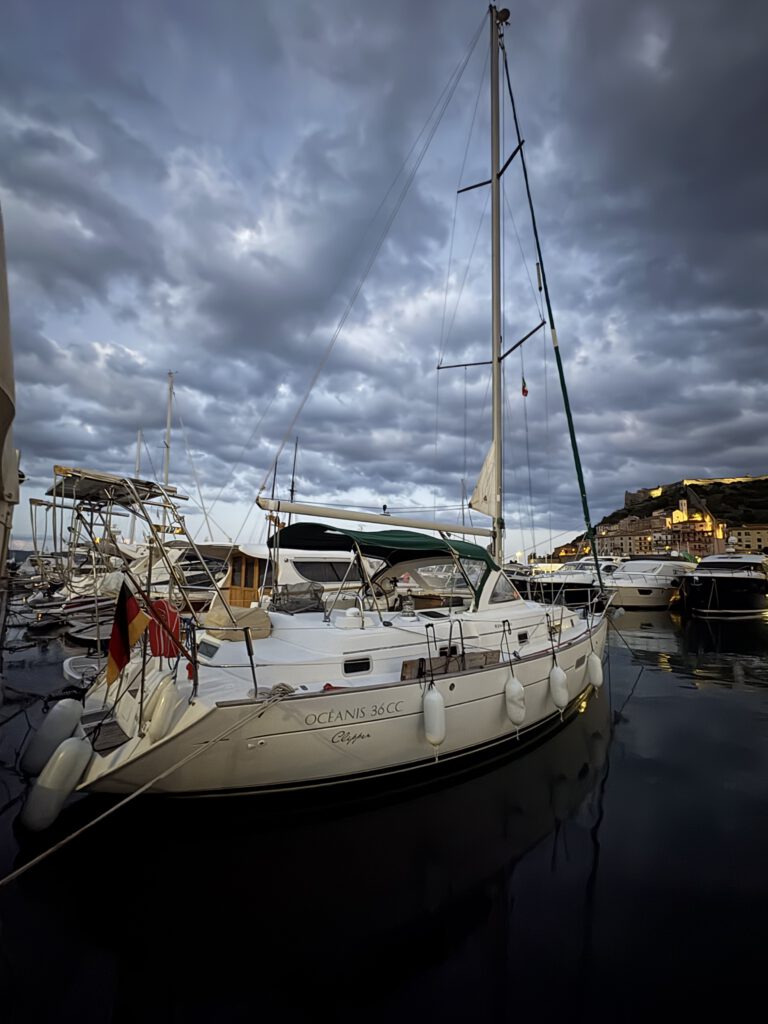
Civitavecchia, Porto Riva di Traiano
Almost at our destination, our next stop is the port of Rome, Civitavecchia. All cruise ships that call at Rome dock here. Ours is the modern Riva di Traiano marina, less than 2 nm from the city. It’s 33 nm to get there, making it a long seven-hour sailing day. We therefore set off early and sail into the sunrise. In the afternoon, the wind picks up and blows from the right direction, allowing us to set sail. Just as we arrive in Civitavecchia, the swell increases unpleasantly, causing SALU to roll from side to side.

Rome, Nautilus Marina
The last leg, with little wind under the engine, takes us to SALU’s new home for the next year. We moor in the Tiber, about 2 nm inland. There are numerous small marinas and shipyards along the riverbed. We chose Nautilus Marina and were warmly welcomed by Olivia, the lady at the reception. In addition to moorings along the river, the marina has a good shipyard and dry moorings.
Six weeks of sailing from the South of France to Rome are behind us. We covered about 560 nm and enjoyed it. SALU arrived here without any major problems. We were able to fix minor repairs ourselves using onboard equipment. Now we are happy and also a little exhausted.
As we enter the river, Michael, a good friend from Lucerne, greets us at the jetty. He has had his classic yacht Kipawa moored here for ten years. The traditional shipyard specializes in classic boats. Furthermore, Rome Fiumicino Airport is only five minutes away. Excellent connections, then.
After three weeks, Jeremy is leaving us again. It was a lot of fun sailing with him, and we look forward to every professional video he creates. Of course, you’re always welcome on SALU.
We’ll spend the next few days winterizing SALU. Afterwards, we’ll treat ourselves to a few days in Rome and return next spring for the next sailing trip. SALU has truly earned its rest. After a few maintenance jobs, she’ll be fit for the next adventure.
